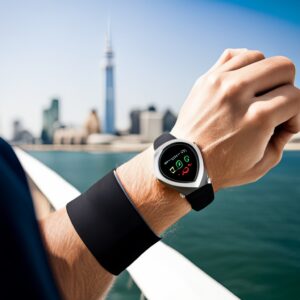When it comes to reaping the full benefits of your workout, sweating it out at the gym or pounding the pavements is only half the battle. Understanding how your body responds to different forms of exercise can be the key to unlocking peak performance and achieving your health goals. This is where heart rate monitors step in – pushing the envelope of physical fitness by putting the power of biometric data right at your fingertips. Whether you’re an elite athlete, a fitness enthusiast, or just someone striving to live a healthier lifestyle, knowing your numbers can make all the difference.
In this comprehensive guide, we explore five compelling reasons why integrating a heart rate monitor into your exercise routine is more than just a fad – it’s a smart investment that can transform the way you approach your health and fitness.
Heart Rate Monitors
Heart rate monitors offer the invaluable benefit of precision training. By enabling users to train at optimal heart rate zones specific to their fitness goals—whether it’s burning fat, improving cardiovascular health, or enhancing endurance—these devices help in tailoring workouts to be more effective. Gone are the days of guesswork and generic training plans. With real-time heart rate data, users can adjust their intensity on the fly, ensuring that every run, bike ride, or gym session is not just about moving more, but also about moving smarter. This targeted approach maximizes the efficiency of workout time, making each session as productive as possible.

1. Hyper-Personalizing Your Workout Intensity
Gone are the days of simply gauging your workout by how much you’re sweating. Heart rate monitors provide real-time insight into precisely how hard your body is working during physical activity. Through this biometric data, you can identify your various heart rate zones, from the low-intensity fat burn to the high-intensity peak performance zone. By staying within the recommended range for your fitness goals, be it weight loss, endurance, or strength, you’re effectively customizing your workout to suit your unique body’s needs – leading to better results without wasted effort.
Monitoring your heart rate allows you to avoid ‘grey areas’ – those mid-range paces where the benefits to your fitness level aren’t well-defined. Instead, you can ensure that each workout serves a specific purpose, making your training regimen smarter and more efficient. By hyper-personalizing your intensity, you’re not just committing to workouts; you’re getting work ‘in’.
2. Unravelling the Mystery of Recovery
The minutes and hours after an exercise session are crucial for recovery. A heart rate monitor doesn’t clock off when you do. Instead, it continues to provide valuable data about how quickly your heart rate returns to its normal state – an excellent indicator of your cardiovascular fitness level and your body’s readiness for the next workout.
By understanding your rates of recovery, you can avoid overtraining and the burnout that comes with it. A sluggish recovery might mean you need more rest before the next intense sweat session. By giving your body the time it needs to recover effectively, you’ll be stronger and readier for peak workouts, ultimately accelerating your progress.
3. Elevating Endurance One Beat at a Time
For endurance athletes, such as marathon runners and cyclists, the challenge is in pushing limits without going too far. Heart rate monitors allow for precise pacing and control during long training sessions and events. By keeping an eye on your heart rate, you can ensure that you’re maintaining a sustainable pace.
This is crucial for preventing early burnout and helps in possibly even faster finishing times. Heart rate monitors transform endurance training from a guessing game of ‘can I keep this pace?’ to a calculated ‘I know I can’. In the world of sports, where seconds can make all the difference, this confidence and control can be game-changing.
4. Tracking Results in Real-Time and Beyond
The joy of progress comes from noticing the small, incremental changes that add up over time. A heart rate monitor allows you to quantify your training progress with objective metrics. Be it a slower pace for the same heart rate or a reduced heart rate during your usual hill climb, these indicators of improved fitness can motivate you to keep going.
Longitudinal data from heart rate monitors can be tracked over months and even years, allowing you to observe trends in your fitness level. Watching your resting heart rate decrease over time as your fitness improves is one of the most rewarding aspects of using heart rate monitors. It’s like watching your health evolve in real-time, data point by data point.
For those interested in integrating heart rate monitoring into their exercise routine but may not know where to start, additional resources can be incredibly beneficial. A detailed plan that aligns with your fitness goals, taking into account the insights gained from your heart rate data, can make all the difference. To help with this, we recommend visiting Building An Exercise Plan, a comprehensive guide that can assist you in creating a personalized workout plan. This resource breaks down the complexities of exercise science into actionable steps, ensuring that your fitness journey is informed, effective, and tailored to your unique needs.
5. Enhancing Weight Loss with Science
While any form of exercise is great for losing weight, exercising within specific heart rate zones can help you burn fat more effectively. The ‘fat-burning zone’ typically represents a lower-intensity exercise level where your body uses fat as its primary source of fuel. Training within this zone, discernible through a heart rate monitor, can optimize your workout for weight loss.
However, it’s important to note that high-intensity workouts, while perhaps burning fewer fat calories, can be more effective at burning overall calories. By balancing these different heart rate zones within your workout routine, you can achieve an optimal caloric burn that targets fat loss while maintaining and improving your cardiovascular health.
For those keen on further exploring the intricate world of fitness tracking and heart rate monitoring, a wealth of resources awaits. Whether you’re a beginner eager to understand the basics or an advanced athlete looking to refine your training strategy, these external resources offer invaluable insights and information.
- American Heart Association: For comprehensive guidelines on heart health and how to interpret your heart rate data effectively, visit American Heart Association.
- Runner’s World: A treasure trove of training tips, including how to leverage heart rate monitors for running, can be found at Runner’s World.
- Cycling Weekly: Cyclists looking to optimize their training with heart rate zones should check out Cycling Weekly, which offers detailed articles and how-to guides.
Each of these resources provides a unique perspective on the benefits of using a heart rate monitor, catering to a wide range of interests and goals within the health and fitness community.
Conclusion: The Pulse of Progress
Your heart isn’t just a muscle; it’s the engine that powers your pursuit of health and fitness. A heart rate monitor is your cockpit, providing you with the necessary gauges and readings to fly your exercise mission with precision. By incorporating one into your routine, you’re not just tracking numbers – you’re tracking your body’s response to the vital activity that keeps it running efficiently. Health, after all, is best in numbers.


